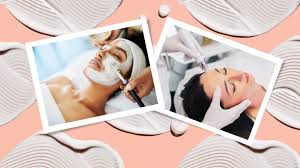
9 Types of Facials: Benefits and What to Know Before Trying Them
Key Takeaways
A facial is a treatment designed to improve the appearance of the skin.
A variety of facials exist, from those that provide a more relaxing, spa-like experience to more medical-grade treatments.
Some facials can address sun damage, as well as certain skin conditions, like rosacea.
Who doesn’t love to feel refreshed and rejuvenated?
That’s one of the big promises of getting a facial. “A facial refers to a specific treatment that is intended to improve the overall appearance of the skin,” says Marisa Garshick, MD, a board-certified dermatologist in New York City and a clinical assistant professor of dermatology at Cornell University in Ithaca, New York.
The term “facial” doesn’t just refer to one specific treatment. “There are many different interpretations of a facial — with some being more focused on massage, applying topical creams, and the overall sensorial experience,” Dr. Garshick explains. Others may focus more on repairing or improving the health of the skin, using evidence-based ingredients, extractions, or other devices to unclog the pores, remove dead skin cells, and brighten the skin overall.
You can get a facial at a spa, med spa, or in a dermatology office, but not all facials are available in every setting — and some types benefit from the oversight of a physician.
What’s more, a facial shouldn’t be used in place of a visit to the dermatologist, either for a regular skin check or to address a skin issue you have going on.
“Facials can help improve conditions that dermatologists treat, but seeing a dermatologist is vital for optimal skin health, as there are treatments that only licensed physicians can provide to treat acne, psoriasis, rosacea, and other skin conditions,” says Jody Alpert Levine, MD, a board-certified dermatologist and the director of dermatology at Plastic Surgery & Dermatology of NYC.
People with specific skin concerns should consult a dermatologist to understand what type of facial may be best for their skin concern and how it can play a role in their treatment.
If you’re new to facials or are interested in exploring a new-to-you type of facial to improve your skin’s health and appearance, here are 9 types to consider.
9 Facials to Boost Your Skin-Care Routine
One of the great things about facials is that you have so many options.
Keep in mind that skin-care centers may use different names for their facials. If you’re interested in something specific, you can always call the location and ask if they have the type of facial you’re interested in.
1. Classic Facial
A classic facial is one that may apply a variety of topical products to the skin to exfoliate dead skin cells and hydrate the top layers of the skin. Some may include extractions, says Garshick. (An extraction is when the esthetician or dermatologist clears a clogged pore.) These types of facials may also be called “deep cleansing facials,” “glow facials,” or “hydrating facials,” among other names.
Generally, facials in this category can be tailored to your skin type and concern. They’re relaxing. And they tend to leave you looking like a refreshed version of yourself.
“It can leave the skin looking lifted, plumper, and brighter, though the results may be temporary,” Garshick explains. If you have sensitive skin, proceed with caution, as products used may cause irritation. Look for one geared toward your skin type. Or ask the spa about the products they use and what may be best suited for your skin.
2. LED Light Therapy Facial
LED (light emitting diode) facials use certain wavelengths of visible light to treat skin. “LED therapy is an easy beauty treatment that exposes your skin to light energy, which is then absorbed into the skin at various depths to stimulate specific reactions in the skin,” says Kristin Gunn, a celebrity esthetician and the owner of Beaux Medspa in Austin, Texas.
Red light, for instance, is used to stimulate collagen-producing cells to reduce the appearance of fine lines and wrinkles.[1] You can expect your practitioner to use a LED device over your skin, which is painless and takes about 20 minutes.[2]
Anyone can benefit from this type of facial, but especially if you have specific skin concerns. For example, LED may be a good add-on treatment for acne or mild psoriasis, since the light may help reduce inflammation, adds Dr. Levine.
Keep in mind that you’ll need weeks of treatments before you see results, such as smoother skin or reduced redness and inflammation, and you’ll need to continue with these facials to maintain those results, Dr. Levine says. It can also be helpful to use an at-home LED mask in between treatments to supplement professional treatment, adds Gunn: “These home devices are not as powerful and contain lower frequencies than professional machines, but are still giving you a skin-care boost.”
3. Microneedling
You can almost think of microneedling as a workout for your face. When you exercise, you damage muscle tissue, which your body builds back stronger. “Microneedling uses a device that has many small needles to stimulate a controlled collagen damage to promote collagen stimulation,” explains Kellie Reed, MD, a board-certified dermatologist at Westlake Dermatology Austin. (Collagen is what provides the structural support to skin.)[3]
“Microneedling is nice for treating acne scars or fine lines,” says Dr. Reed.
It’s also considered a safe and effective tool for hyperpigmentation related to acne scars on people with dark skin.[4]
4. IPL Photo Facial
Intense pulsed light (IPL) is another light-based device that can treat discoloration from sun damage, says Reed. The light penetrates the top layer of skin to destroy cells contributing to discoloration or broken blood vessels. These cells or blood vessels are eventually broken down and reabsorbed into your body.[5]
“It’s good for sun spots, freckles, age spots, as well as broken blood vessels that contribute to rosacea and general redness,” she says. If you have melasma (a facial skin condition where tan, brown, or bluish gray patches and spots develop, often during pregnancy), you should avoid IPL, as it can make discoloration worse.[6] You’ll need to go in for a series of IPL treatments for best results.[5]
5. Hydrafacial
A hydrafacial is a specific, patented treatment with three steps: cleansing and exfoliation, extraction (which involves suctioning out debris from pores), and hydration with moisturizers.[7]
“It can help treat congested pores and dry skin,” says Reed. You may also be able to add on a mild chemical peel (more on this procedure below) to also treat skin discoloration and fine lines, she adds.
It’s safe for most people, although if you have a rash, sunburn, or moderate to severe acne or rosacea, a hydrafacial may be too harsh for your skin, so talk to your dermatologist about options that are better for you. If you’re pregnant, check with your ob-gyn first, since it uses salicylic acid.
6. Chemical Peel
Chemical peels involve applying an exfoliating acid to the skin, which may include glycolic, salicylic, mandelic, or lactic acid, says Garshick.
At Levine’s office, a glycolic acid peel is the most common, simplest peel she performs. This involves applying glycolic acid solution (a type of alpha hydroxy acid) onto the face for a few minutes to remove dead skin cells. The result is skin that looks smoother in texture and brighter, she says.
There are various strengths of chemical peels, which is governed by the concentration of the acid as well as how long it’s left on skin, Levine adds. This means they can be tailored to beginners or someone looking for a stronger treatment. That’s great news, especially if you’re new to chemical peels. Tell your dermatologist or esthetician if it’s your first one; they can talk to you about the appropriate strength you need for your goals.
Another thing to keep in mind: After receiving a chemical peel, your skin may peel — though not everyone’s does, says Garshick. So you’ll really want to talk about what to expect before getting one.
7. Firming or Sculpting Facial (or ‘Microcurrent Facial’)
While there is not a standard definition for a firming or sculpting facial, these often employ techniques like facial massage, microcurrent (which uses a low-level electrical current to stimulate collagen), or radiofrequency with the goal of tightening and lifting the skin, explains Jackie Spagnuolo, NP, an aesthetic nurse practitioner and the owner of Beauty Nurse NYC.
“Results can include firmer, more contoured skin, but they may require maintenance treatments for longer-lasting effects,” she says.
Because the category includes a wide range of treatments, it’s a good idea to talk to the practitioner first to understand the tools and treatments used and if each is suitable for your skin type and concerns.
8. Microdermabrasion
“Microdermabrasion is a form of physical exfoliation to get rid of dead skin cells,” explains Garshick. During this treatment, an instrument is used that propels tiny crystals against the skin that removes the outermost layer of the epidermis (skin).[8]
But remember that microdermabrasion can be irritating and lead to scarring (in some cases). So, it’s not appropriate for all skin types, Garshick says.
“Some people may like the immediate glow they see after,” she says. But, it’s not recommended for everyone. “It should be avoided by those with sensitive skin,” she says.
9. Dermaplaning
You can think of dermaplaning as shaving your skin. “It gently scrapes away dead skin cells and removes ‘peach fuzz’ to reveal a smoother, brighter complexion,” says Gunn.
This facial is best for someone who’s looking for a brighter skin tone, she says. But if you have sensitive or very dry skin, this can be too irritating. In that event, Gunn recommends “oilplaning,” which is a treatment that uses oil as the skin is scraped.


